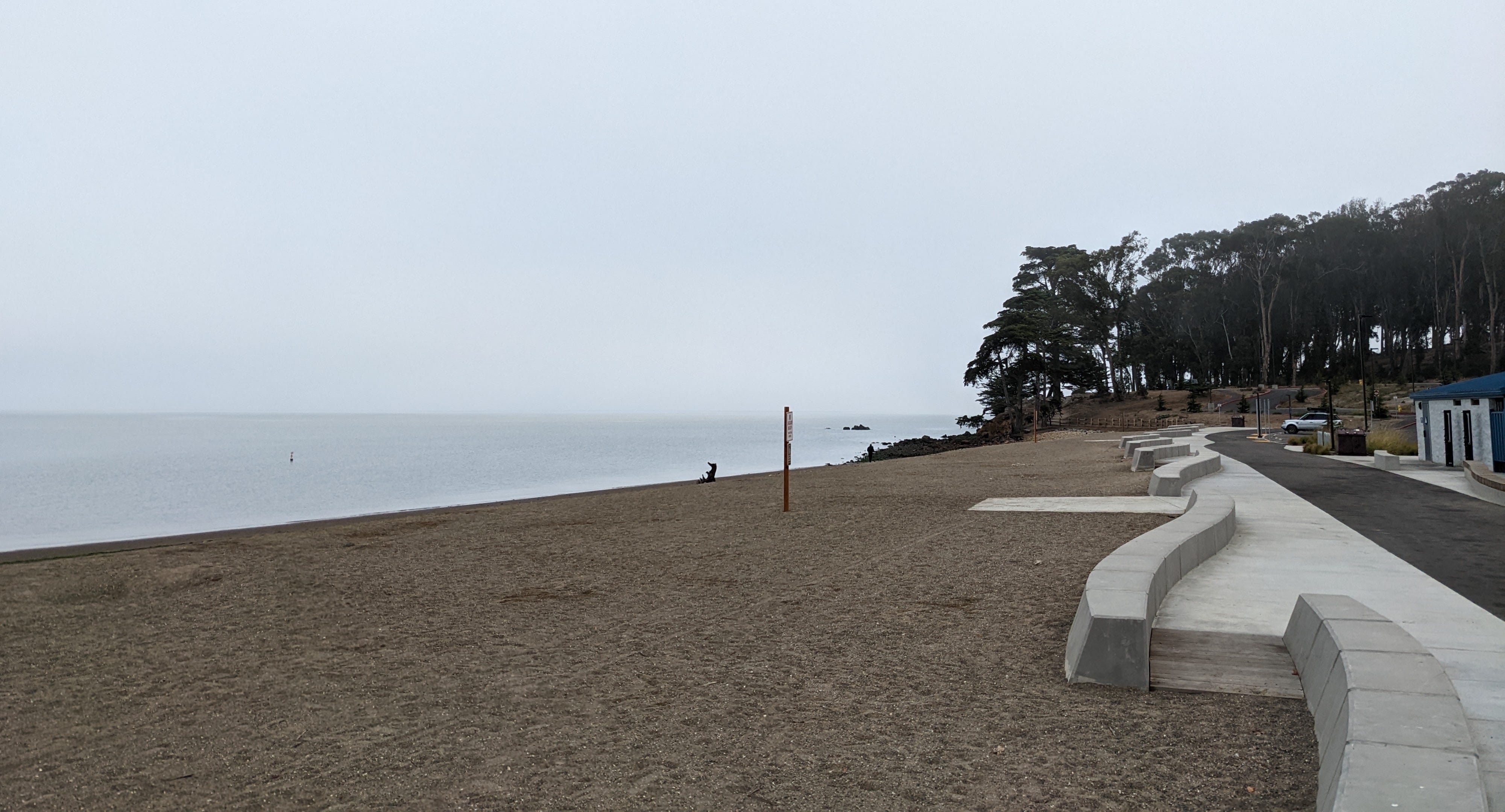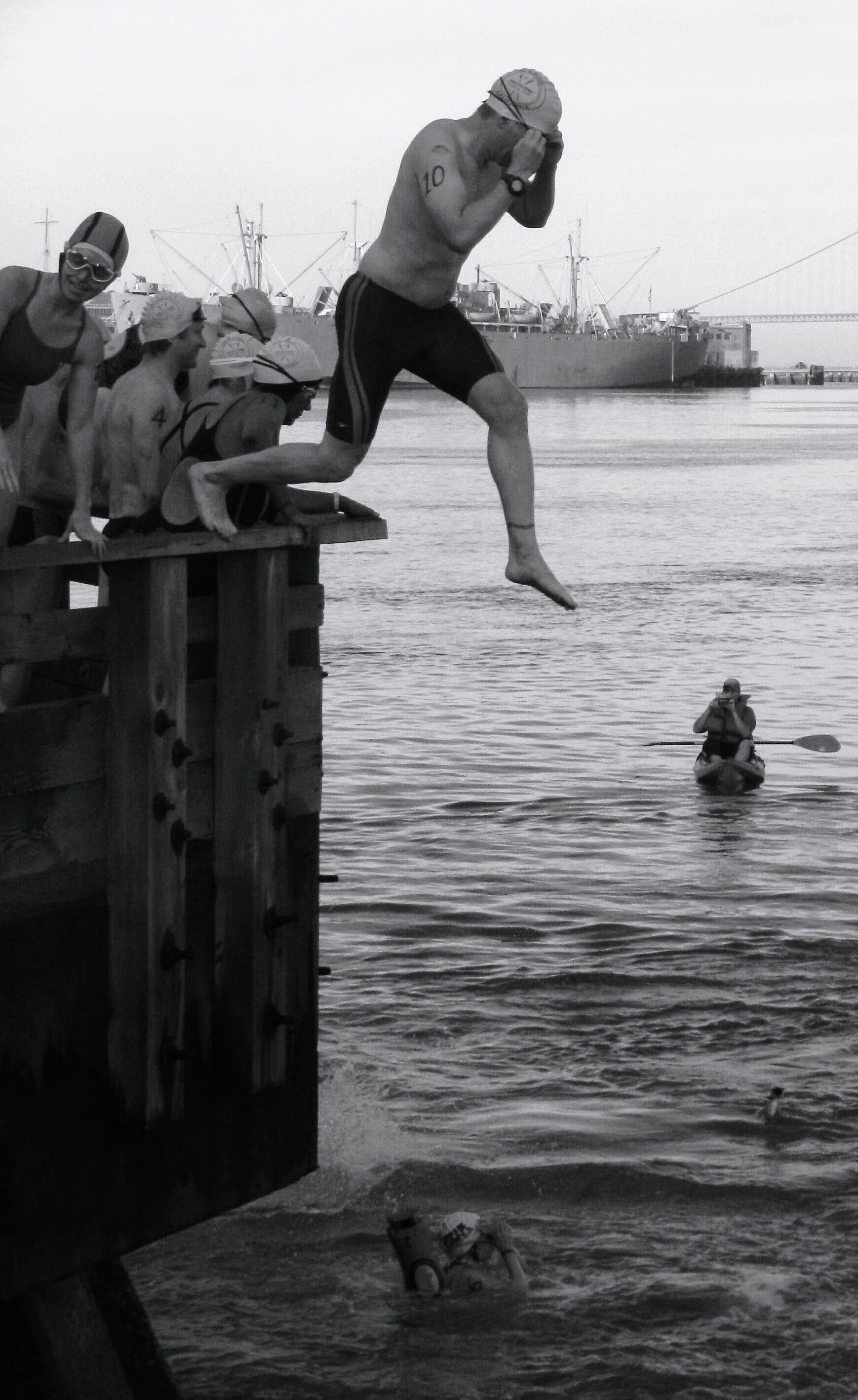
Listen to the podcast version of this issue.
I’m standing on the edge of the San Francisco Bay in San Mateo, my bare toes gripping the blocky concrete ramp installed a few years ago to help windsurfers get in and out of the water. Before me, the greenish water of the Bay is slightly ruffled by a gentle wind, and in the distance, the city of San Francisco twinkles in the morning haze.
Thanks for reading Postcards from the Waterline! Subscribe for free to receive new posts and support my work.
To my left, just half a mile away, is the north-south corridor of the 101, an endless vein of commuter traffic connecting San Francisco with Silicon Valley. Next to it, the bright horizontal lines of Meta's new Burlingame campus shine out, a clean, expensive-looking set of buildings on the waterfront, where engineers are creating a world of virtual reality, accessible only to those willing to strap on a headset and trade the real world for one made of polygons.
To my right is real reality: San Mateo’s “wild coast,” a low bluff of sandstone topped with eucalyptus. At the foot of the bluff, the water I will be swimming in laps against the rocks. Shorebirds mill about in the water: Coots, scoters, and buffleheads, their patterns of black and white seeming to sparkle as they paddle, dive, and resurface. Somewhere behind me, crows caw at each other in the parking lot.
It’s March, and a chilly wind blowing across my shoulders reminds me not to stand there too long. I walk a few steps into the water, until it’s up to my knees, and then bend down, swirling my hands around in it and splashing some on my face. The water’s about 52 degrees Fahrenheit, or about 11 degrees Celsius — chilly enough to provide a shock to the system when you first get in.
My swim watch tells me that my heart rate is 82 beats per minute, reflecting my excitement and the reaction to the cold water. The watch also lets me know that it has acquired a GPS signal and is prepared for me to start my swim. Its screen says, simply: Ready.
I take a few deep breaths, and dive in.
I'm a writer and a swimmer, and over the next few months, I'm going to share a bit about both. Swimming, as it turns out, is a powerful way to reboot one's life — and so is writing.
Ten years ago, I could barely swim four lengths of a pool without getting out of breath. I loved the ocean and was fascinated by San Francisco Bay, but I was terrified of open water’s unpredictable currents and waves, so my enjoyment of it was limited, like most people’s, to occasionally splashing around in waist-deep surf.
Emphasis on occasionally. A longtime tech journalist, I’d spent the two decades since college with my eyes glued to a screen and my fingers on a keyboard. I was lucky to arrive in Silicon Valley just as the power and influence of magazines and newspapers was cresting and just as the personal computing revolution was beginning to pay enormous dividends for business users.
I wasn't trained as a journalist — I learned on the job, working first for a monthly computer magazine, and then for a weekly newspaper, InfoWorld, targeting business users of technology. The PC revolution had given way to a networking and client-server revolution, wiring computers up in local area networks connected to powerful and flexible servers. As the years went on, those local networks got linked into the global network of the internet, which in turn became a revolution of its own. I followed the technologies, writing about them and using them.
When mobile technology started to pick up steam, I helped start a magazine, Mobile PC, to chronicle that trend. Later, I joined the staff of WIRED. That gave me a front-row seat to the mobile revolution kicked off by the debut of the iPhone in 2007. Then, in 2011, I transitioned to leading the news team at VentureBeat, where we told stories about the global business transformation wrought by digital technologies and entrepreneurship.
Four technology revolutions in twenty years. It was a good time to be a tech journalist, even though the business of journalism itself got hollowed out by the last two of those transformations, the internet and mobile. There were endless stories to tell, an unstoppable stream of new products to review, and plenty of opportunities for writers and editors with an eye for change and a sense of how to tell a story.
Yet with the collapsing business model of journalism, it was also a nerve-wracking time to be in this line of work. I found success as a writer and editor, but I also felt an implacable need to keep paddling constantly just to stay afloat.
The weeks and months tumbled together like beach stones in surf, knocking around in a swirl of energy and activity, hard to tell apart. Like many parents, I felt like I blinked and my kids were suddenly teenagers. I was approaching fifty, and all I had to show for it was a big stack of old news articles and product reviews that were already obsolete a week after they’d been published.
Was this it, I wondered?

I eventually found renewal through swimming. An approach called Total Immersion helped me learn to swim more mindfully and in a more balanced way, which increased my ability to swim for longer periods — thirty minutes, sixty minutes, two or three hours at a time.
My body acclimated to spending time in the cold waters of San Francisco Bay, which hover in the mid 60s Fahrenheit in the summer and get as low as 50F in the winter. No, I don't wear a wetsuit! I became a distance swimmer, swimming from the Golden Gate Bridge to AT&T Park one year, and from Capitola to Santa Cruz the next (a 10-kilometer swim).
All that swimming made me more aware of my body and my breathing, and that in turn led me to more formal, sitting meditation and a regular Zen practice. I found a measure of peace of mind. I slowed down a bit, I stopped drinking, I connected with swimming and mindfulness communities, and I believe I became a somewhat better person.
At the same time, forced to write and edit on my own schedule instead of the nonstop reactive pace of a newsroom, I became a better and more self-motivated writer.
And I realized I had learned a lot about how to recognize, craft, and deliver stories.
Like open-water swimming, there's a hard way and an easy way to write. Everyone knows the hard way: You throw yourself against the task, bashing out words one after another no matter how painful it may be: "Just open a vein," as the saying goes. And when you just can't find the words, you bang your head on the keyboard and wish you had chosen a different line of work.
I prefer the easy way. In open water swimming, you need to figure out how to balance yourself, trusting the water to hold you up. You need a plan of where you're going, how you'll get back, and where you'll bail out if you run into trouble. You need to acclimate yourself to the cold. And you need to swim mindfully, using the water as your friend instead of battling against it.
In writing the easy way, you need to find your internal balance, trusting the language to hold you up once you know what you want to say. You need an outline to guide you — and the willingness to abandon it when the story wants to go another direction. You need to practice, a lot, preferably writing for an audience, until you get acclimated. And you need to write mindfully, finding the seam of the story and following it like a current. Those currents are there, and once you learn to see them, they will carry you.
I now work as the head of editorial for a PR and marketing agency, Highwire, that works with tech companies. Some of our clients are big, recognizable brands; others are small companies that you probably haven't heard of — yet. I do a lot of message development and content strategy creation. I also write, edit, and do a bit of coaching.
I bring these insights to my work with clients every day: Trying to find the seam of the story, the current that carries a client's message forward with ease and resonance.
I still swim in San Francisco Bay every week, usually several times, and I find the water (and the people who love it) a rich source of inspiration and renewal. Some of the people I swim with are amazing sources of stories themselves.
Over the next few months, I'll be sharing the story of how I became an open-water swimmer and the effect it’s had on my life over the past decade. There will be some stories about actual swims, some of the lore and science of the ocean, and some meditations on swimming. There will also be a bit about meditation and my discovery of a more mindful way to live.
Along the way, I will share some secrets of storytelling, writing, and strategic communications — some of what I’ve learned over the years as a technology journalist, writer, and editor.
So for the next few months, this blog is going to be a bit of an experiment.
My goal is to bring you an interesting story or essay, at least once a week, and maybe spark some conversations. Most of them will be under 1,000 words (much shorter than this one). They'll be available right here and via my Substack newsletter, Postcards From the Waterline.
If you prefer to listen, check out my podcast, Reset Button, where I’ll be reading each installment and, in time, talking to some fascinating people about their stories.
I hope you'll follow along with me on this journey. Please let me know what you think about any of the stories, and feel free to ask me questions as well. I'd love to hear from you.
Let's jump in.

Thank you to Chris Angelis for editing help, via Foster.
Thanks for reading Postcards from the Waterline! Subscribe for free to receive new posts and support my work.



